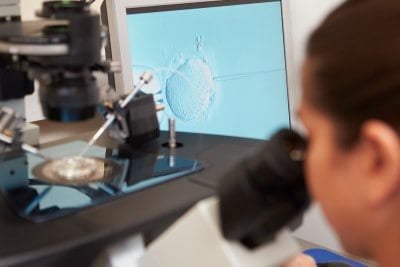If it’s your first time undergoing IVF, you might have various questions at each stage. This is very common and only natural. At this phase, you may be wondering what goes on before the embryo transfer occurs.
You’ll often hear your IVF fertility team refer to the embryo as a ‘blastocyst’. However, most individuals don’t fully understand what this means. In this article, we’re going to lay it all out for you. What is a blastocyst exactly? What are the benefits of a blastocyst transfer? Let’s find out.
What is a Blastocyst
After five days, the fertilized egg becomes known as a blastocyst. Essentially, this is a ball of cells that rapidly divide. The inner cells eventually develop into the embryo, whereas the outer cells provide protection and nourishment to the growing embryo — or eventually the fetus. Note: At ELITE IVF, our signature Hybrid Frozen Embryo program has set a new standard by promising a staggering 100% more viable blastocysts for IVF treatment when using egg donation. The typical frozen egg banks offer around 1-2 blastocyst guarantee. Yet, ELITE IVF offers a minimum of 4 blastocysts.
Blastocyst vs Embryo
So, what’s the difference between a blastocyst vs an embryo? In fact, they are often the same thing. To understand this further, let us explain.
A blastocyst contains about a hundred cells. This is what the embryo is referred to between days five and six, which is usually when the embryo reaches the uterine cavity for implantation. This blastocyst technically develops into an embryo around day 10 to 12 after fertilization. This usually corresponds with the fifth week of pregnancy, which is when the amniotic sac begins to develop.
Day 5 Embryo
The ‘Day 5 Embryo’ is also known as a ‘Day 5 Blastocyst.’ These are sometimes used interchangeably. As previously mentioned, the embryo, at this stage, contains approximately a hundred cells that are divided into two types of cells. One type of cells develops into fetus tissue, while the second type of cells develops in the placenta.
Blastocyst Transfer
By now, you may be wondering why a blastocyst transfer is performed. There are many benefits associated with transferring the embryo at this stage in development. We’ll review these in the sub-section below.
Benefits of Blastocyst Transfer
There are many scientific reasons for transferring a blastocyst. The most common ones include synchronicity with the endometrium lining and the fact that blastocysts are considered high-quality embryos that are more likely to implant.
Higher Success Rates Associated with Blastocyst Transfer
Generally, it is well-known among fertility experts that the embryo has a higher chance of implantation on days 5 and 6 as opposed to the earlier days of development. This is because this mimics what happens naturally within the body. By days 5 or 6, the embryo has made its way to the uterus to implant. When your fertility team is able to implant the embryo on the same days that this would happen naturally, it’s more likely that implantation will occur and thus, so will a successful pregnancy.
Lower Risk of Multiple Pregnancies
By transferring the day 5 embryo, your fertility team is able to reduce the number of embryos transferred. In turn, this means you are less likely to have multiple pregnancies, such as twins or triplets, which can happen with the transfer of multiple embryos.
Blastocyst Grading
Blastocyst grading, or embryo grading, is a process where your fertility team analyzes how the blastocyst, or embryo, looks. We’ll explore this process in greater detail below.
Blastocyst Size Grading
Generally, blastocyst grading involves measuring the group of cells on a scale from 1 to 6. Blastocysts with fewer cells are given lower ratings, such as a 1 or a 2. This often means that they won’t be used for the embryo transfer stage. Blastocysts are graded based on their inner cell mass and their trophectoderm.
Inner Cell Mass Grading
The inner cell mass goes on to develop into the fetus. This part of the blastocyst is given a letter grade based on normal appearance and the number of cells. Only blastocysts with an inner cell mass graded A or B are selected and reflect a normal appearance.
Trophectoderm Grading
The trophectoderm refers to the outer cells in the blastocyst which go onto become the placenta. These cells are also important since they are the part that implants in the uterus. These are also given a letter grade, with A or B being the most ideal outcome.
The success rates of blastocyst transfer are much higher than transferring an earlier-stage embryo. Simply put, by mimicking the natural process of implantation, you’re more likely to conceive.
At ELITE IVF, our compassionate and experienced team is here to help you every step of the way. Contact us today to begin your journey toward making your baby dreams become a reality. We pride ourselves to have been leaders in offering high-quality blastocysts as part of our Frozen Embryo Program for egg donation patients, setting an industry standard and pushing for excellence in clinical outcomes. Ask us about our guaranteed blastocyst programs.


